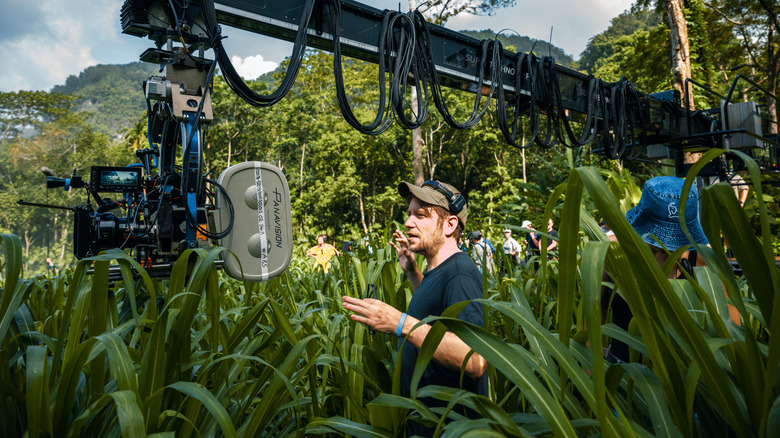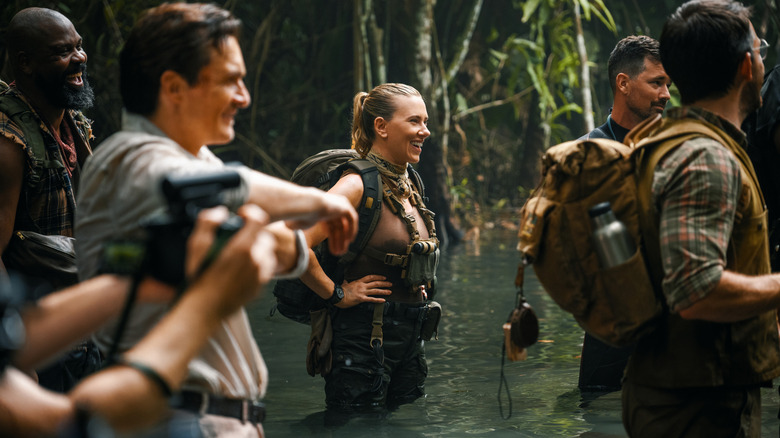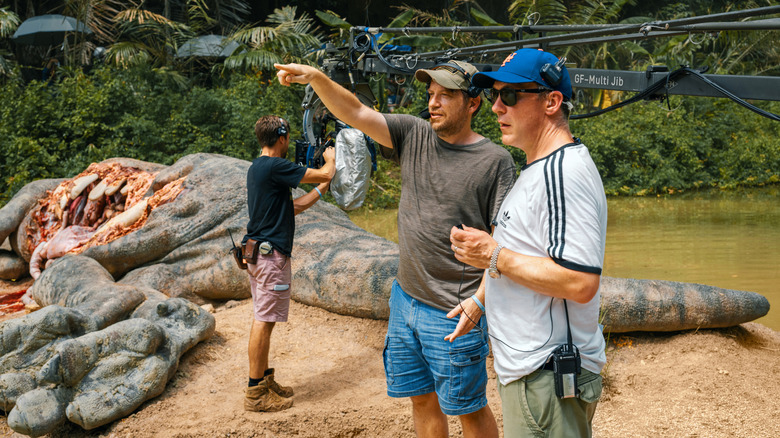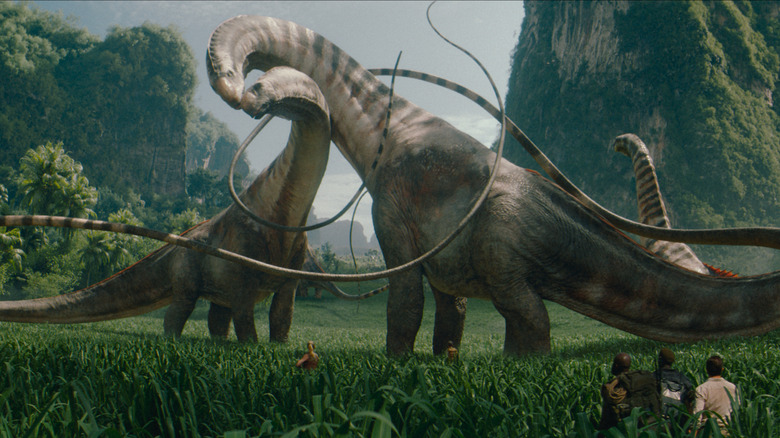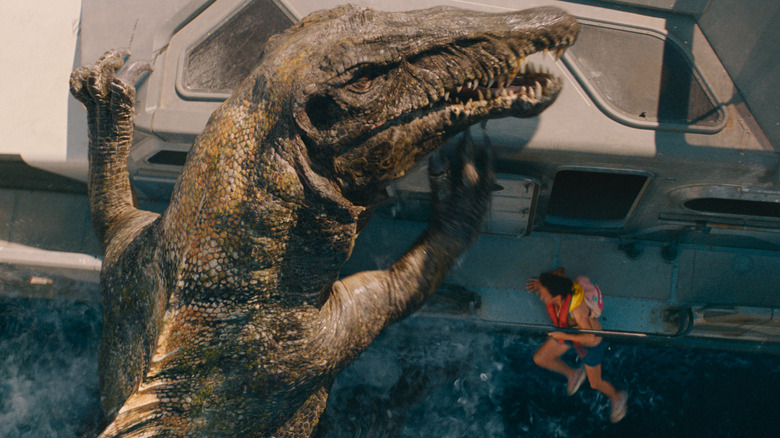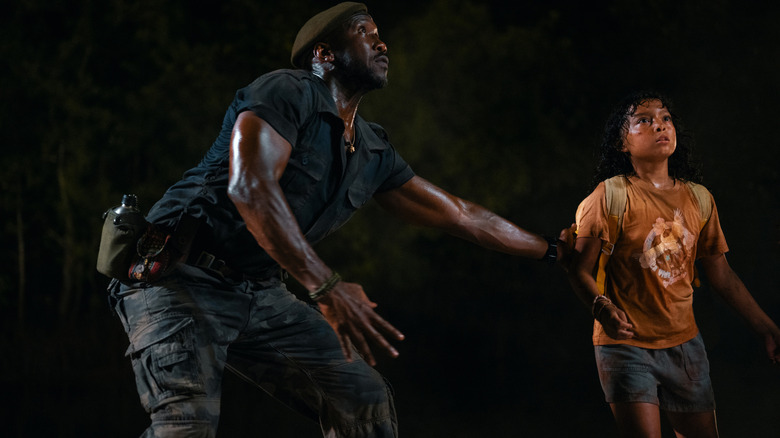One Thing Makes Jurassic World Rebirth Different From Star Wars And Godzilla, According To Gareth Edwards [Exclusive Interview]
Prior to his work on "Jurassic World Rebirth," director Gareth Edwards might be most easily described as the "Star Wars" guy and the "Godzilla" guy — though he has far, far greater ambitions than that. Originally a visual effects artist before making the jump to feature films, his unique background provided him with a career path that turned out to be perfectly suited for big-budget Hollywood blockbusters. This skillset is apparent even in his original features, such as 2010's aptly-named kaiju flick "Monsters" and especially his ambitious movie "The Creator" from a couple years back. To nobody's surprise, however, he's also found himself at the helm of several major IP plays, from 2014's underrated "Godzilla" to "Rogue One: A Star Wars Story" to the latest installment in the "Jurassic" franchise.
Whatever you do, just don't call Edwards a "journeyman." Few filmmakers know the advantages and perils of taking on ambitious studio projects quite like he does, yet something keeps bringing him back anyway. It's safe to say that the production of "Jurassic World Rebirth" was even more intimidating than most, namely due to Universal Pictures putting this sequel on the fast track in order to have a summer blockbuster ready by the 2025 corridor. That time crunch meant significantly narrowing down the field of capable directors, which the trades once described as a search for more of a "shooter" than an "auteur." Thankfully, Edwards' distinctive fingerprints are all over the final product.
Prior to the release of "Rebirth," I sat down with Edwards for an extensive and in-depth interview to pick his brain about all facets of his newest film. We discussed how this compared to his experiences on "Godzilla" and "Rogue One," balancing CGI and visual effects versus practical dinosaur animatronics, the factors that went into the ending (including an alternate ending we didn't see), and plenty more.
Note: This interview has been lightly edited for clarity and brevity.
Jurassic World Rebirth differed from Gareth Edwards' experiences on Godzilla and Star Wars in one major way
I'm going to ask you to get a little introspective here, if you will.
Gareth Edwards: Yeah, please.
I won't ask you whether you consider yourself an "auteur" director or a journeyman, but how do you look at yourself and your body of work overall and the labels that you either rejected or embraced along the way?
I think any filmmaker probably starts off hoping they're an auteur and then spends — if they're very lucky and they get to do stuff — spends the next part of their career being really worried they're not and they're just this journeyman you're talking about. And so, I really hope not. It keeps me awake at night. I mean, basically that's all I'm doing my whole life is just trying not to be that guy. But, equally, I grew up with "Star Wars," "Godzilla," "Jurassic Park," and I want to play in those sandboxes. If someone gives me them, I'll take it. So, it's super exciting. But then the game becomes, how do you do something that doesn't feel like you're just doing a karaoke number and singing someone else's song? You want to contribute. Yeah, it's really tricky.
Did you feel like playing in the "Jurassic" sandbox compared favorably or less so to "Star Wars" and "Godzilla"?
I think the big difference on this movie compared to anything else I've done — there's a couple of differences. One of them was, we had a screenplay. It is the first time I've ever started a film and started pre-production and there's a script that the producers, the studio, the writer, everyone else is pointing at and going, "We're going to go do that." Normally, the tug of war is, what is this movie? The fact that everyone was on the same page...
What was also super interesting was David Koepp. People were — you read a script and you go, "Okay, I'd like to do the following things," and they're a bit like, "Good luck getting that past David," and so I thought, "Oh no." My first meeting with him was on Zoom and as soon as the Zoom appeared, behind him was a poster of "King Kong," the original. I was like, "Oh, you like 'King Kong'?" We just started talking about "King Kong," and then talking about monster movies. I don't know how [much time] went by — half an hour, an hour — and just realized we had exactly the same taste in films. I think that was so helpful in the short time we had, because everyone wants to make a great film. That's all anyone wants to do. The only conflict ever is, what is a great film? If you can agree on that, you are halfway there.
This movie also — add to that fact that, from the day you get the first call, to the day you deliver the movie and it's done — it's usually two and a half years, and this was a year and a quarter. There was something about the fact that we didn't have time to mess around. You couldn't second-guess yourself. You had to go with all your first instincts. My editor [Jabez Olssen] put a quote on the door to the edit suite that said, it was Leonard Bernstein and it said, "Art is when you have a plan and not quite enough time," and it really rang true. Not that we've made art or anything, but it rang true that not having quite enough time is actually quite good. If you have too much time, you procrastinate, you try things that don't work, you don't have that file lit under you.
Also, we delivered — we showed the studio the "director's cut," and then you looked at the schedule and to hit this release date, it was like, we can't mess around. Like, "Give us your notes and, in two weeks, we've got to kind of lock the movie." They gave us all their feedback, we did it. Everyone was happy, and that's the movie. It was quite weirdly straightforward, you know what I mean? There were definitely difficult times, but I look back on it now and I get more rose-tinted with it and I'm like, this was quite a straight path. And I think it all came down to that script, really.
Writer David Koepp was the 'secret weapon' on Jurassic World Rebirth
I've seen a few behind-the-scenes images where it seemed like David Koepp was on set with you guys, at least for part of the production. How big of a voice did he have after the script was locked and during production?
[Pulls out his phone] David Koepp is my secret weapon in that, on my phone, I can text him any time of the day. And I would ask him questions, or I would ask him to invent some different dialogue or something. It was like having this uber ChatGPT app. There'd be these little moments where you'd go, "I just need to fill this — when they walk from here to here, they need to say this thing." And I'd type my bad version, just as a framework, and then I'd hit send thinking, "If he doesn't write back, we're about to shoot it, if he didn't write back in half an hour, we just have to go with my bad version." Then suddenly my phone, like a minute later, would go [text sound] and then I'd look.
And it was really depressing, because it would be so well-written. And it'd be the perfect balance of a little arc, it was thematic, had a joke in it or something. I'm like, "How do you do that?" He's really good at the things I struggle with. It's like getting blood out of a stone with me, things like that, so I really had a good time with him. I think it was great.
I'm curious how you approach the fandom and the lore of it all, with this being such a big franchise movie. I mean, you know better than most, audiences are really passionate about this sort of stuff. If you change one little thing, then there's a whole — was that ever even on your mind at all, what their reaction could be?
Yeah, the audience is on your mind the entire time. That's all you're making the movie for, slightly. But then, you fail the day you make a movie for someone else. As soon as you go, "I don't like this, but they'll like it," it's game over. So, you have to go, "What do I want to see? What do I like?" And as a "Jurassic" fan, I feel confident — I think, one of the other keys is, you've got to really love this stuff. Because you're going to be using your gut the whole time, as you navigate left and right, the whole way.
So, you do dream of that moment. I would sit with the monitor and we'd be in Thailand and I'd put my T-shirt over it so I could see [through the glare], then I'd get my fingers and I would put them in front of the screen to create little heads in the cinema. And I'd watch it back as if I was actually sat in the cinema and people were in the way.
[laughs] That's great.
I would, as a fan, go, "Oh, you know what you should have done." You know, when you sit and watch a movie, it's really easy in retrospect, it's easy to be a Monday morning...
Quarterback, right.
Quarterback. So, you're trying to be that Monday morning quarterback. You're trying to watch your own film like [pantomimes yelling at the screen], "Oh, you know what? You should have done this! You didn't do that!" and then hear it and then go on set and go, "Hey, let's tweak it and do this instead." It's a very hard trick to pull off when you're surrounded by 400 people and all that.
To Gareth Edwards, green screen is 'not a solution, it's a problem'
It almost sounds silly to say this, but watching this movie, it's just so refreshing to see the cast actually wading through swamps and cutting their way through jungles and stuff. Obviously you used soundstages, but what was it about the tactility of filming on location that you felt like you needed to bring to this movie?
To be honest, it was less about the actors' performance, because they're great actors. They're going to do amazing, even if they were against blue screen or green screen. But it was more about me, selfishly, in that my background was visual effects. The thing you learn really hard in visual effects is that, when someone just puts a green screen or a blue screen up, it's not a solution, it's a problem. I mean, you go, "I don't know what the hell is behind this person," and it's really hard to make that look good. Whereas, if you're in a real-world situation, even if you end up replacing that background with something else, if you've got something that feels compositionally beautiful, you can add to it afterwards.
And obviously, the dinosaurs, what we all agreed was that we should shoot — there should be a plate for everything. Nothing should be pure CG. There should always be footage. Then we're just adding, in theory, adding the dinosaur to the footage. That becomes hard when you have water. There's a whole scene in our movie where we had a load of ocean photography, because we had to do CG water. But yeah, they pulled it off. It's the best — I mean, I cannot tell you the fake water versus the real water. It's spot on.
Do you have any "Apocalypse Now" horror stories of lugging these big 35-millimeter cameras through the jungle? Was there anything that went wrong or in the process that you were just worried about?
No. You know what's weird is, that's what everyone's fear is. Because when you shoot on film, that's something that's physical, something might break. On every movie I've done, I've lost something or lost time because of something to do with the camera, maybe. And, on this, I didn't. They've shot on film for nearly a century or whatever it's been, maybe a century, and they've got it down. I mean, the mechanics of that is all working. Those cameras are really heavy. You hold it, but the second you start recording and it goes [makes film camera noise], it starts to feel like it's breathing and it's alive, like you're holding an animal, the weirdest thing is, because you're doing "Jurassic," it's like carrying millions of people in your hand. You know, because of just the nature of this film, millions of people are going to see exactly this moment.
You are holding them. There's nothing else I can think of where you're holding millions of people, and it's such a strange feeling that the camera becomes weightless. It's like if there's a car accident, there's scenarios where mothers can just pick up the car and get the kid. It's like that. When you're holding millions of people, it doesn't weigh a thing. The second you say "cut," your back wants to break [laughs], you know what I mean? I would hold the camera because I could convince myself — I could only see what the audience could see, is three people, I could convince myself I'm making a small film with just my friends. It was only when you'd say "cut" and look around and see 400 people over there that you'd go, "Oh God, we're doing this big movie, aren't we?"
Here's why the Spinosaurus looks so different in Jurassic World Rebirth
Now, as a big dinosaur nerd, I do have to ask you about the dinosaurs.
Yeah.
Whose idea was it to redesign the Spinosaurus into something more scientifically accurate, compared to the movie monster version we saw in "Jurassic Park III"?
I was worried that I'd steered it towards a movie monster version, and that it used to be really accurate. It's like, imagine we are dinosaurs, the world is full of dinosaurs, we are dinosaurs, and they make a movie about some humans. And someone goes, "Hey, we're going to have some Asian guy in this scene," and you go, "But be more specific," right? And they go, "Oh no, but it's just an Asian." It's like, you can have a Spinosaurus, and then you can have a totally different-looking one. This idea that there's only one type of dinosaur is crazy.
Basically, I saw it as, "Okay, in the last movie, if that was Clint Eastwood, now we're going to have Marlon Brando." So it was more, "Okay, let's just get that Spinosaurus and start to push and pull shapes and proportions and try to make more of a character out of it." I don't know, I can't really explain, but I look at two images just like in nature, and you personally can go, "That's more attractive" or "I find more interesting than that," and sometimes you can't articulate why, you just go, "That one. I prefer that one." Then you take that one, that's the new one, and you mess around with it and you make two children and you say, "That one." And you take that one, you mess around with it, and it's basically like nature. You're trying to evolve an idea and it's very much probably what happens in nature. So yeah, I did a bit of that with the dinosaurs as well, even though some of them have been established. Otherwise, you don't really have your fingerprint on it. It felt like it's one of the first things you do, is grab all the toys and you want to make them your own, kind of thing.
In "Jurassic Park" tradition, going back all the way to the original, it's always been a mix of cutting-edge visual effects and practical effects. Correct me if I'm wrong, but it feels like "Rebirth" leans more towards the VFX side of things rather than puppets, animatronics, that sort of thing. What went into that decision for you?
Yeah, I mean, my background was computer graphics, visual effects. The thing you learn the hard way, I guess, on some of these movies, is you go to a lot of trouble doing something practical and sometimes you end up replacing it in the computer. And it can be really worth it, because it was a great reference. It gave the actor something to react to on set, and it can all be great. But we had a year and a quarter, and so it felt like we didn't have time to do pre-viz, all that animation that people do of the stunt sequences and set pieces. It also felt like animatronics — like big, cool, crazy animatronics — were not going to happen in time. And it all would've been a lot of resources and time and we could probably not have got through this one with just puppets and stuff.
What we did do is, we ended up asking them to do what we called proxy puppets. Essentially, they create shapes and silhouettes that were full-scale, whatever the creature was, and then they could come into a room and puppeteers would come in and they play their animal, and that way we can compose the shot. They don't look like dinosaurs, you know what I mean? But they're enough to make the actors react to something, and they look scary. We had these Mutadon puppets and the whole scene cut together and worked perfectly with just the puppets in, because the guys who were operating them, like, I don't know what makes you want to do that for a living [laughs], but they could tap into something pretty dark. Yeah, it was all mainly just proxy objects, stuff that could push doors open and things like that, but not actually — then it gets replaced with the real photoreal dinosaurs.
Gareth Edwards explains the Jurassic World Rebirth ending and reveals an alternate version of events
Final question, a spoiler question: Towards the end, you leave the D-rex alive. There's no big dinosaur-on-dinosaur confrontation like we've seen in a lot of these other "Jurassic" movies. I was half expecting the T-rex to come in and make another last-minute save, or the Mosasaurus to come in and drag it into the water or something. What went into that for you?
I thought about — that came up. It didn't come up on the shoot, it came up in post-production where I just suddenly, I guess I woke up in a cold sweat one night and was like, "Should we, should we have the T-rex turn up?" [laughs] I went in the next day and brought this up with everybody and I expected everyone to go [enthusiastically], "Yeah!" and it was just a reaction like, "Really? But all the other ones did that." It slightly kind of reassured me like, "Okay, I think that we did the right thing." But there's this storytelling thing called [deus] ex machina and it's like Latin, I think, for God basically coming and saving your characters at the end of a story. I think "Jurassic" has this thing called "Rex Machina" where the T-rex comes and saves everyone.
I remember David [Vickery], the visual effects supervisor, he was like, "But that's one of the things I loved about this film is that it didn't do what the other ones did" and all this sort of stuff. Yeah, you do juggle these — there's like, what's the right thing here? You try and choose the right path. I do love — my favorite part of the film is the ending in terms of the ... I mean, we are in spoiler territory, right?
Yeah, spoilers are fine.
Yeah. I'll tell you, the bit we did shoot two versions of is Kincaid living and dying.
Wow.
We had — basically, the version where he dies, you just don't have the other bit [where he reappears]. But because that was how it was written to start with and we filmed it and did everything as if he was going to die, everything felt correct. As an audience you go, "Oh my God, he's going to actually die, and of course he is," and then he does. Then when he's brought back, I think it is a surprise. Then I felt like, "Oh no, what if the audience thinks we copped out?" Then I would remind myself of "E.T.", which is the masterpiece version of this, where I never felt that at all in E.T. I felt really sad [laughs] that he had gone, then euphoric when he was back. It was kind of like a little version of that where you sort of pray: "Is the audience going to ...?" And then watching it the other night [at the New York premiere], it got the best reaction in that moment and I was really like, "Oh my God, thank God we shot that version where he lived because it could have been quite a downer [laughs]."
"Jurassic World Rebirth" is in theaters now.
